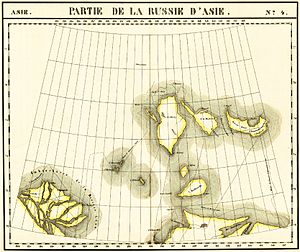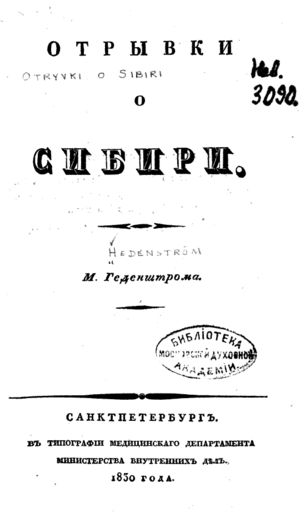Matvei Gedenshtrom facts for kids
Quick facts for kids
Matvei Gedenshtrom
|
|
|---|---|
| Born | 1780 |
| Died | 1845 (aged 65) Khaidukovo near Tomsk
|
| Occupation | Explorer |
Matvei Matveyevich Gedenshtrom (Swedish: Mathias Hedenström; Russian: Матвей Матвеевич Геденштром; 1780 – 2 October [O.S. 20 September] 1845) was a Russian explorer who journeyed through Northern Siberia. He was also a writer and worked for the government.
Matvei Gedenshtrom was born in Riga, which was part of the Russian Empire at the time. His father, Mathias Hedenström, was a Swedish refugee. Matvei was still a Swedish citizen in 1798.
Early Life and Challenges
Gedenshtrom studied at the University of Tartu. However, he did not finish his studies there. Instead, he started working at the customs office in Tallinn. Until 1806, he worked in Riga as a translator for Count Friedrich von Buxhoeveden. Count Buxhoeveden was the Governor-General of the Baltic provinces.
In 1808, while working as a secretary, Gedenshtrom faced legal troubles. He was arrested and then sent to live in Siberia.
Exploring the Arctic
Later in 1808, Gedenshtrom arrived in Irkutsk. He received an important task from the Minister of Commerce, Nikolay Rumyantsev. His mission was to explore the coastline of the Arctic Ocean. Gedenshtrom did not have a strong science background. He had to learn a lot to figure out a location's latitude and longitude. He also learned how to use scientific tools.
Gedenshtrom led a cartographic expedition to map the New Siberian Islands. He worked with Yakov Sannikov and land surveyors Pyotr Pshenitsyn and I.Kozhevin. During this trip, the idea of Sannikov Land began. This was a theory about a landmass northwest of Kotelny Island. Gedenshtrom also found the Siberian polynya. These are areas of open water in the sea ice.
In 1809, Gedenshtrom visited the eastern shores of an island. Merchants Semyon and Lev Syrovatsky had found it three years earlier. Gedenshtrom named it New Siberia, and this name became official in 1810. He mapped the coastline between the mouths of the Yana and Kolyma rivers. He also traveled many times across Yakutia and areas east of Lake Baikal.
Later Career and Legacy
In 1813, Matvei Gedenshtrom worked for the Irkutsk governor's office. Later, he became the head of the district police in Verkhne-Udinsk. This job did not stop him from doing scientific research. He continued to collect minerals and plants. Matvei Gedenshtrom was known as a smart, talented, and kind person. He often helped local peasants with advice and money.
In 1819, Mikhail Speransky, the governor general of Siberia, visited Irkutsk. He found many problems with how local officials were acting. On February 20, 1820, Matvei Gedenshtrom was removed from his job. He faced serious accusations of misusing his power and money. A special committee looked into Speransky's report. Gedenshtrom was placed in a group that meant he could not hold public jobs again. He was also sent to live in a different part of Russia.
However, it was soon decided that he would stay in Siberia, in Tobolsk. The government in Western Siberia wanted to use his skills. They got permission for him to work for the government again. In 1827, Gedenshtrom was allowed to return to European Russia. He then worked for the Medical Service Corps. In the 1830s, Matvei Gedenshtrom became a postmaster in Tomsk. After he retired, he moved to a village called Kaidukovaya near Tomsk. He died without much money on September 20, 1845, at age 65. He was buried in Tomsk three days later.
Works
Matvei Gedenshtrom shared his scientific discoveries in several books and articles:
- Gedenshtrom’s Journey Across the Arctic Ocean and its Islands, Which Lie to the East of the Lena’s Estuary (1822)
- Description of the Arctic Ocean coastline from the Yana estuary to Cape Baranov (1823)
- Notes on Siberia (1829)
- Sketches on Siberia (1830)
- Islands Between the Lena and Kolyma (1838)
- New Siberia (1838)
- Heads of Unknown Animals Found in Northern Siberia (1838)
- On Baikal (1839)
- Material for the Description of Siberia (1841)
- Siberia (1842)



